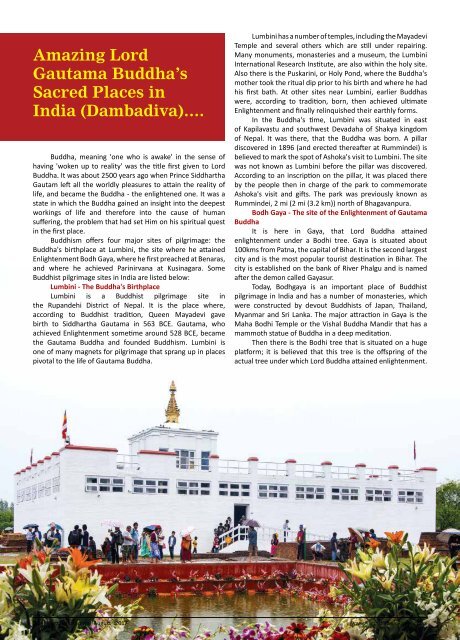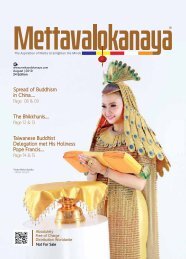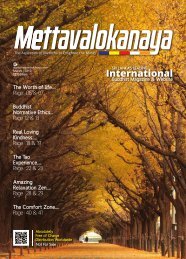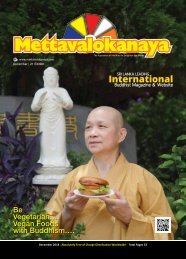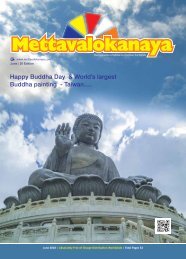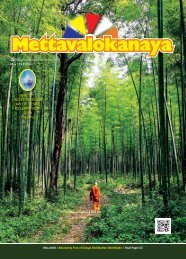Mettavalokanaya_Magazine_August_2017
“Mettavalokanaya” International Buddhist Magazine has been successfully distributed to 40 countries including all districts across Sri Lanka and now “Mettavalokanaya” is Sri Lankan Most Popular & Leading monthly Buddhist Magazine.
“Mettavalokanaya” International Buddhist Magazine has been successfully distributed to 40 countries including all districts across Sri Lanka and now “Mettavalokanaya” is Sri Lankan Most Popular & Leading monthly Buddhist Magazine.
You also want an ePaper? Increase the reach of your titles
YUMPU automatically turns print PDFs into web optimized ePapers that Google loves.
Amazing Lord<br />
Gautama Buddha’s<br />
Sacred Places in<br />
India (Dambadiva)….<br />
Buddha, meaning 'one who is awake' in the sense of<br />
having 'woken up to reality' was the title first given to Lord<br />
Buddha. It was about 2500 years ago when Prince Siddhartha<br />
Gautam left all the worldly pleasures to attain the reality of<br />
life, and became the Buddha - the enlightened one. It was a<br />
state in which the Buddha gained an insight into the deepest<br />
workings of life and therefore into the cause of human<br />
suffering, the problem that had set Him on his spiritual quest<br />
in the first place.<br />
Buddhism offers four major sites of pilgrimage: the<br />
Buddha's birthplace at Lumbini, the site where he attained<br />
Enlightenment Bodh Gaya, where he first preached at Benaras,<br />
and where he achieved Parinirvana at Kusinagara. Some<br />
Buddhist pilgrimage sites in India are listed below:<br />
Lumbini - The Buddha's Birthplace<br />
Lumbini is a Buddhist pilgrimage site in<br />
the Rupandehi District of Nepal. It is the place where,<br />
according to Buddhist tradition, Queen Mayadevi gave<br />
birth to Siddhartha Gautama in 563 BCE. Gautama, who<br />
achieved Enlightenment sometime around 528 BCE, became<br />
the Gautama Buddha and founded Buddhism. Lumbini is<br />
one of many magnets for pilgrimage that sprang up in places<br />
pivotal to the life of Gautama Buddha.<br />
Lumbini has a number of temples, including the Mayadevi<br />
Temple and several others which are still under repairing.<br />
Many monuments, monasteries and a museum, the Lumbini<br />
International Research Institute, are also within the holy site.<br />
Also there is the Puskarini, or Holy Pond, where the Buddha's<br />
mother took the ritual dip prior to his birth and where he had<br />
his first bath. At other sites near Lumbini, earlier Buddhas<br />
were, according to tradition, born, then achieved ultimate<br />
Enlightenment and finally relinquished their earthly forms.<br />
In the Buddha's time, Lumbini was situated in east<br />
of Kapilavastu and southwest Devadaha of Shakya kingdom<br />
of Nepal. It was there, that the Buddha was born. A pillar<br />
discovered in 1896 (and erected thereafter at Rummindei) is<br />
believed to mark the spot of Ashoka's visit to Lumbini. The site<br />
was not known as Lumbini before the pillar was discovered.<br />
According to an inscription on the pillar, it was placed there<br />
by the people then in charge of the park to commemorate<br />
Ashoka's visit and gifts. The park was previously known as<br />
Rummindei, 2 mi (2 mi (3.2 km)) north of Bhagavanpura.<br />
Bodh Gaya - The site of the Enlightenment of Gautama<br />
Buddha<br />
It is here in Gaya, that Lord Buddha attained<br />
enlightenment under a Bodhi tree. Gaya is situated about<br />
100kms from Patna, the capital of Bihar. It is the second largest<br />
city and is the most popular tourist destination in Bihar. The<br />
city is established on the bank of River Phalgu and is named<br />
after the demon called Gayasur.<br />
Today, Bodhgaya is an important place of Buddhist<br />
pilgrimage in India and has a number of monasteries, which<br />
were constructed by devout Buddhists of Japan, Thailand,<br />
Myanmar and Sri Lanka. The major attraction in Gaya is the<br />
Maha Bodhi Temple or the Vishal Buddha Mandir that has a<br />
mammoth statue of Buddha in a deep meditation.<br />
Then there is the Bodhi tree that is situated on a huge<br />
platform; it is believed that this tree is the offspring of the<br />
actual tree under which Lord Buddha attained enlightenment.<br />
The Chaukramama or the Jewel Walk is yet another place of<br />
interest in Bodhgaya; it is said that this was the spot where<br />
Buddha used to come for a stroll.<br />
Sarnath - The site of the first sermon<br />
Sarnath is situated about 11kms from the holy town<br />
of Varanasi. It is a place where Budhha after attaining<br />
enlightenment proceeded to deliver his first sermon on<br />
wisdom. Today, Sarnath is one of the most important Buddhist<br />
places of worship in India. The main attraction here is the<br />
stupa that was erected by Emperor Ashoka in 3rd century BC.<br />
Other major attractions in Sarnath are Chaukhandi<br />
Stupa, which is believed to have been constructed during<br />
Emperor Ashoka’s reign; it is in fact the first monument<br />
encountered after entering Sarnath. Another important place<br />
to see in Sarnath is the Dhamek Stupa, which is a conical<br />
structure that signifies the place where Buddha delivered<br />
his first teachings of the Four Noble Truths. Mulagandha Kuti<br />
Vihar and Sarnath Museum are yet other major attractions for<br />
the tourists in Sarnath.<br />
Kushinagar - The site of the Buddha's paranibbana<br />
Kushinagar is located about 53 km from Gorakhpur<br />
and is believed to be the place where Lord Buddha attained<br />
‘Maharparinivana’- the highest stage of salvation. After the<br />
excavation in 1861 many stupas related to Buddha resurfaced<br />
in Kushinagar and today they are amongst the major tourist<br />
attractions here. The Ramabhar Stupa is one of the major<br />
attractions; this stupa is about 50 feet tall and situated where<br />
Lord Buddha was cremated.<br />
Mahanirvana Temple, where a six meters long Buddha<br />
statue in reclining position is kept; Mathakuar Temple, where<br />
a black stone image of the Buddha and inscriptions dating back<br />
to 10th-11th century are kept; Watt Thai Temple; Japanese<br />
Temple, where ‘Eight Metals’ statue of Lord Buddha is kept<br />
and the Chinese Temple, which is predominantly constructed<br />
in a Chinese architectural style are the other places to see in<br />
Kushinagar.<br />
Other Buddhist holy sites are Patna, Bihar - Formerly<br />
known as Pataliputra, it was the seat of the Mauryan<br />
Empire and a significant Buddhist centre. Rajgir, Bihar -<br />
Formerly known as Rajagaha, it was the capital of Magadha,<br />
ruled by King Bimbisara, one of the most prominent monarchs<br />
and supporters during the lifetime of the Buddha.<br />
Nalanda, Bihar - Site of an ancient Buddhist university,<br />
destroyed by Bakhtiyar Khalji during Islamic attacks.<br />
Sravasti, Uttar Pradesh - Formerly known as Savatthi, it was<br />
the capital of Kosala, ruled by King Pasenadi, one of the most<br />
prominent monarchs and supporters during the lifetime of<br />
the Buddha. Vaishali, Bihar - Seat of a republican state of<br />
the Lichchavis, prominent supporters of the Buddha. Site of<br />
the Second Buddhist Council.<br />
The name of Bihar is derived from vihara, meaning<br />
monastery, such was the association of the area with<br />
Buddhism. In addition to these sites which were visited by the<br />
Buddha, other sites in India have become notable:<br />
Sanchi, Madhya Pradesh - Site of a large stupa<br />
built by Ashoka, it also stored the relics of Sariputra and<br />
Mahamoggallana, the two chief disciples of the Buddha;<br />
reputedly the place from which Mahinda set out to<br />
proselytise Sri Lanka.<br />
Ajanta and Ellora, Maharashtra - the site of intricate cave<br />
paintings depicting Buddhism. Nagarjunakonda, Bavikonda,<br />
Thotlakonda, Salihundam, Amaravati, Andhra Pradesh,<br />
Ratnagiri, Odisha, Lalitgiri, Odishaand Udayagiri, Odisha -<br />
former sites of Buddhist education.<br />
Wijaya Wagaarachchi<br />
After visit in India<br />
Sponsored by Air India<br />
38 I <strong>Mettavalokanaya</strong> I <strong>August</strong> I <strong>2017</strong><br />
www.meththawalokanaya.com<br />
www.meththawalokanaya.com<br />
<strong>Mettavalokanaya</strong> I <strong>August</strong> I <strong>2017</strong> I 39


